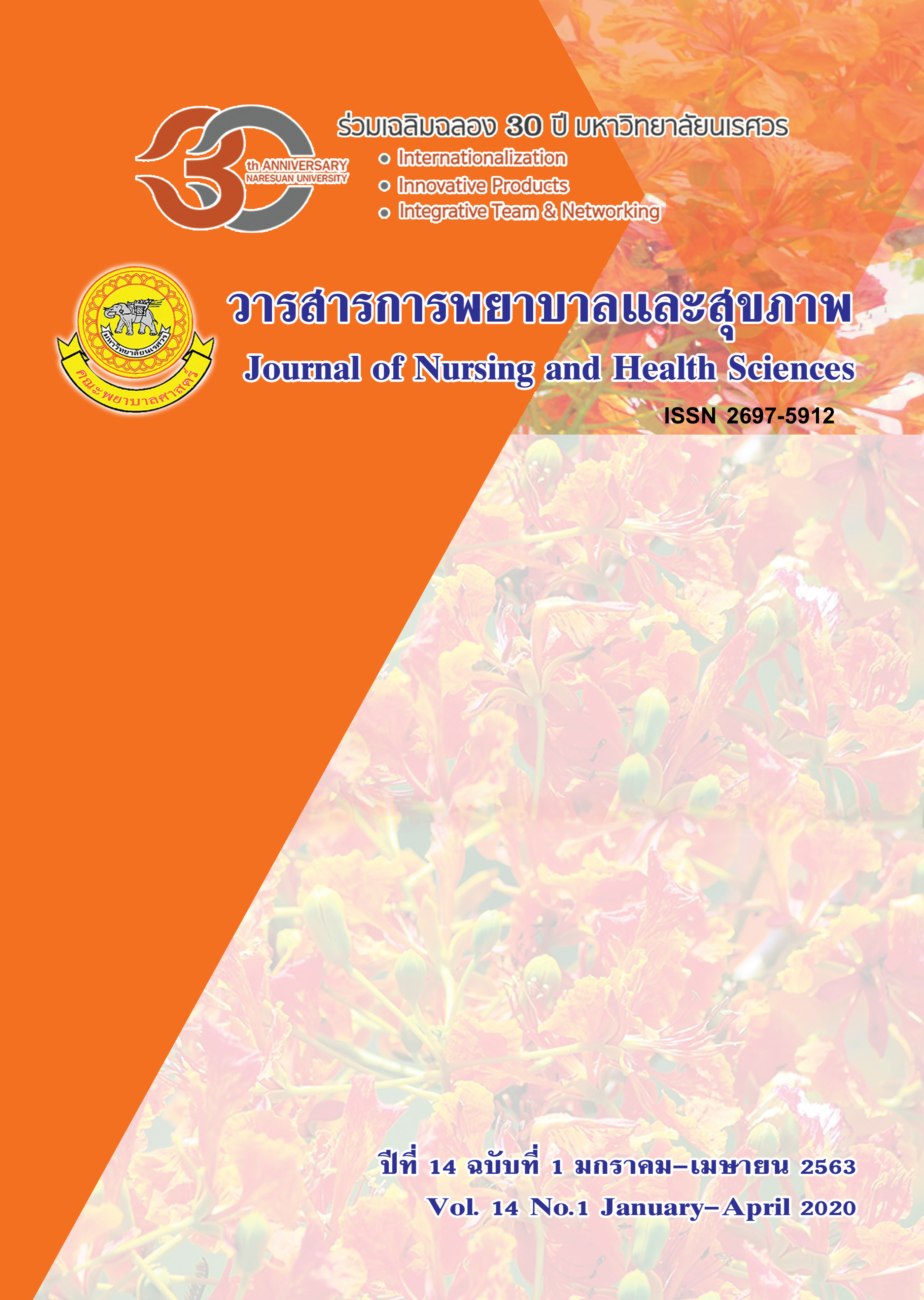The Effects of Participatory Guidance Program on Perceived on Health Belief and Disease Preventive Behaviors in Diabetes Mellitus Risk People
Main Article Content
Abstract
The purpose of this one group pretest-posttest design was to compare the perceptions onhealth belief score and diseasepreventive behaviors of people at risk with diabetes mellitusbefore and after receiving the participatory guidanceprogram. The sample group consisted of 32 people who had been screened with at least 3 risk factor for diabetes mellitus. The two research instruments of this study included 1) the experimental intervention which was a participatory guidance program, its content composed of 1.1) making relationships, 1.2) evaluating and analyzing risk factors together, 1.3) summarizing the findings and exchanging of opinions, 1.4) establishing guidelines for prevention of disease together, and 1.5) following and encouraging the implementation of the agreed guidelines, and 2) the instruments for data collection including health belief questionnaires, and diseasepreventive behavior questionnaires. General data, health belief, and diabetes mellitus preventive behavior data were analyzed using descriptive statistics such as frequency, percentage, and paired t-test statistic was used to compare the average score. The results showed that after receiving the participatory guidance, the mean score of health belief and diabetes mellitus preventive behaviors were significantly higher than before receiving the participatory guidance ( = 1.87, S.D. = 0.17; = 1.75, S.D. = 0.20), ( = 1.62, S.D. = 0.22; = 1.47, S.D. = 0.19) at p-value .001. From this research, it was found that the participatory guidance has led to diabetes mellitus at risk group with having higher levels of health beliefs and behaviors to prevent diabetes mellitus. Therefore, the participatory guidance program can effectively increase perceived health beliefs and disease preventive behaviors inDiabetes Mellitus at risk people
Article Details
References
American Diabetes Association. (2017). Classification and diagnosis of diabetes. Diabetes Care, 40(Suppl 1), S11-S24.
Bandura, A. (1977). Social learning theory. New Jersey: Prentice-Hall.
Chaichana, H., Awiphan, R. & Sirisatayawong, P. (2014). Effect of health education program for modifying health belief and behavior to prevent diabetes mellitus in risk group, Pa Sang District, Lamphun Province. Master Thesis,Chiang Mai University. Chiang Mai. [In Thai].
Chindawattanawong, A., Piasue, N. and Ninthachan, P. (2012). Relationship between health belief perception and type 2 diabetic preventive behaviors in high school students. Ramathibodi Nursing Journal, 18(1), 58-69. [In Thai].
Dejaphan, M. (2012). Factors influencing diabetes prevention behavior of disease risk groups, Ubon Ratchathani Province. Journal of Graduate School Phitchayarat Ubon Ratchathani Rajabhat University, 7(1), 84-93. [In Thai].
Diabetes Association of Thailand. (2017). Clinical practice guideline for diabetes 2017. Pathum Thani: Romyen Media Company Limited. [In Thai].
Don Yai Hom Health Promoting Hospital. (2018). Public health information of Don Yai Hom Sub-district, 2018. Annual report. Nakhon Pathom: Don Yai Hom Health Promoting Hospital. [In Thai].
Ekkapolakorn, W. (2014). Report of the 5th Thai Health Survey by physical examination 2014. Nonthaburi: Publisher by Graphic and Design. [In Thai].
Group of Public Health System Development, Division of Non Communicable Disease, Department of Disease Control. (2018). Campaign issues for World Diabetes Day 2017. Retrieved 20 September 2018 from http://thaincd.com/document/file/info/non-communicable-disease/2560.pdf . [In Thai].
National Statistical Office. (2017). Number of population in Nakhon Pathom province. (Online). Retrieved 25 January 2018 from http://www.nso.go.th./gender/table/tab1.htm. [In Thai].
Phermsin, S. (2011). The effects of the application by health belief model and social support to control blood sugar among diabetes mellitus type 2 patients, Ubolratana District, Khon Kaen Province. Khon Kaen University Research Journal (Graduate Studies), 11(4), 89-100. [In Thai].
Pumwisaid, J. (2014). Health belief and health behaviors among diabetes mellitus type 2 patients, Phato Hospital, Chumphon Province. Region 11 Medical Journal, 8(1), 89-100. [In Thai]
Rosenstock, I.M. (1974). Historical origins of the health belief model. Health Education Monographs, 2(4), 328-335.
Rosenstock, I.M., Strecher, V.J. & Becker, M.H. (1988). Social learning theory and the health belief model. Health Education Quarterly, 15(2), 175-183.
Sompan, A., Theerathong, S., Piaue, N. & Sakun Hongsopon, S. (2015). Factors predicting diabetes preventive behavior in persons with pro-diabetes. Ramathibodi Nursing Journal, 21(1), 96-109. [In Thai].
Srihang, N. (2010). Estimation of the population of diabetes in Thailand in the year 2011-2020. Weekly Epidemiological surveillance report, 41(39), 622-4. [In Thai].
World Health Organization. (1999). Health impact assessment: main concepts and suggested approach European Centre for Health Policy. Copenhagen: WHO Regional Office for Europe.


